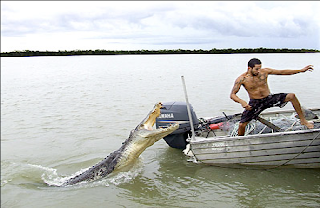
There are only two species of Alligator left in the world. Firstly, as most people know, there is the American alligator (alligator mississipiensis), which can be found widely distributed across the south-eastern United States, most typically in the Florida Everglades. There is also a second extant species of alligator, although this one is much rarer and confined to the upper Yangtse River valley in China. Scientists had thought that the less aggressive alligator had been "weeded out" of its range by crocodiles, leaving the only representatives of the Alligatoridae family in these isolated pockets. The more efficient crocodiles grew faster and may have been better at consuming food but this is generally regarded as speculation - as in the case of the American alligator, this species competes with the native American crocodile (C. acutus). The American alligator can withstand cold spells far better than the American crocodile, and as a result, has a much more extensive range in the United States.
Crocodiles and Alligators kill hundreds of people every year. While most of these fatal crocodile attacks occur in Africa and Asia it is important to note that these powerful reptiles are also found in parts of Australia and America (especially in the Southern States). Humans are typically not part of a crocodile's diet, but in truth they will eat just about anything that moves. They are also very territorial, especially during mating season, and will violently defend themselves even if you mean them no harm. The best option is to give crocodiles and alligators plenty of space and be cautious around water where they may live. In the unlikely event that you are attacked, you may be able to survive if you implement these simple instructions.
1. Stay away from infested waters. This is the simplest way to avoid a crocodile attack. Ask local authorities or residents about the presence of crocodiles in lakes and rivers in your area and don't go swimming outside the designated swimming areas. These animals actively hunt at night when they are hardest to see, so avoid swimming at dusk or at night.
2. If you have spotted a crocodile it is a good idea to stay at least 10 meters away from them so that you have room to escape. Often crocodiles can produce short bursts of speed and can take you by surprise if you are too close. If you are passing a crocodile you do not want to frighten it by coming up behind it. Slap your oars on the water or make a sound so it knows you are there. Crocodiles will sometimes defend themselves violently when they are startled. They are much faster in water so if you know that the water is infested you probably won't want to go swimming or even go near the water.

4. Fighting if you are attacked. If it has you between its jaws it will not let go. The power of their bites are virtually impossible to escape by struggling your way out. Also if you struggle the animal is more likely to do a death roll which is generally what crocodiles do to rip limbs off animals. The best option is to poke or press your finger into its eye. While they have you in their clamp the only way for the crocodile or alligator to escape an eye gouge is to let you go. The eyes are the most vulnerable part of a crocodile or an alligator's body. This is the prime target and it will work nearly every time.
If you cannot reach the eyes for some unknown reason you could also go for the nostrils or ears. Many people have been saved by whacking the snout of a crocodile. This is less likely to work but it may be your only option. If you have been dragged under water you could always go for the palatal valve. Crocodiles and alligators have a flap of tissue behind their tongues that cover their throats and prevents water from getting into their stomach. If you can pry this valve open and allow water to rush down its throat then it will most likely let you go.


